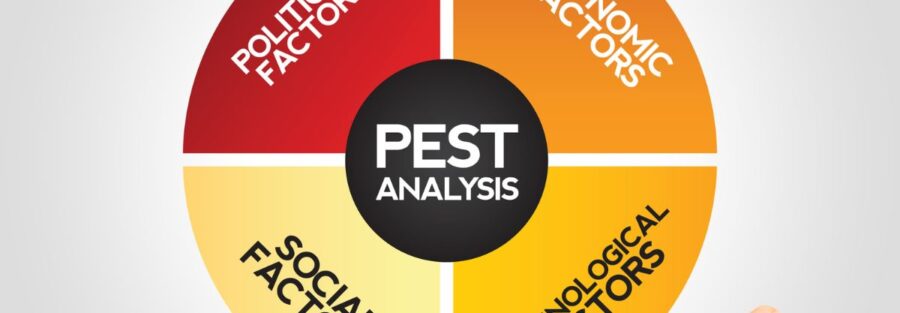The Value of a PEST Analysis
Chief Information Security Officers (CISOs) must navigate a complex landscape of threats and opportunities. To effectively protect their organizations, CISOs need to understand the broader external environment that impacts their security strategies. One valuable tool for this purpose is the PEST analysis. PEST stands for Political, Economic, Social, and Technological factors. In this blog post, we will explore the value of a PEST analysis to CISOs, detailing how it can enhance their strategic planning, risk management, and decision-making processes.
Understanding PEST Analysis
PEST analysis is a strategic framework used to evaluate the external factors that can influence an organization. By analyzing these factors, CISOs can gain insights into potential risks and opportunities that may affect their cybersecurity posture. Let’s break down each component of the PEST analysis:
- Political: This factor examines the impact of government policies, regulations, and political stability on the organization. For CISOs, understanding the political landscape is crucial for compliance and anticipating regulatory changes.
- Economic: Economic factors include economic growth, inflation rates, and economic stability. These factors can affect the organization’s budget for cybersecurity initiatives and influence the overall risk environment.
- Social: Social factors encompass societal trends, cultural attitudes, and demographic changes. These factors can impact user behavior, employee practices, and the organization’s approach to security awareness and training.
- Technological: Technological factors involve advancements in technology, innovation trends, and the adoption of new technologies. For CISOs, staying abreast of technological changes is essential for maintaining a robust security infrastructure.
The Value of PEST Analysis for CISOs
A PEST analysis provides CISOs with a comprehensive understanding of the external environment, enabling them to make informed decisions and develop effective security strategies. Here are the key benefits of conducting a PEST analysis:
Enhanced Strategic Planning
PEST analysis helps CISOs incorporate external factors into their strategic planning processes. By understanding the broader context in which their organization operates, CISOs can develop more robust and resilient security strategies.
- Informed Decision-Making: PEST analysis provides valuable insights that inform decision-making. CISOs can align their security initiatives with external trends and anticipate potential challenges and opportunities.
- Long-Term Perspective: By considering political, economic, social, and technological factors, CISOs can adopt a long-term perspective in their strategic planning. This helps in setting realistic goals and preparing for future developments.
Improved Risk Management
Understanding external factors is crucial for effective risk management. A PEST analysis enables CISOs to identify and assess risks that may arise from the external environment.
- Identifying External Threats: PEST analysis helps CISOs identify potential threats originating from political instability, economic downturns, social changes, or technological advancements.
- Proactive Risk Mitigation: By anticipating external risks, CISOs can implement proactive measures to mitigate their impact. This includes adjusting security policies, investing in new technologies, or enhancing employee training programs.
Enhanced Compliance and Regulatory Awareness
Political factors, including government policies and regulations, significantly impact cybersecurity practices. A PEST analysis helps CISOs stay informed about regulatory changes and ensure compliance.
- Regulatory Compliance: By monitoring political developments, CISOs can ensure their organization complies with relevant regulations and standards. This reduces the risk of legal penalties and reputational damage.
- Anticipating Regulatory Changes: PEST analysis enables CISOs to anticipate potential regulatory changes and prepare accordingly. This proactive approach helps in avoiding disruptions and maintaining business continuity.
Better Resource Allocation
Economic factors, such as budget constraints and economic conditions, influence resource allocation for cybersecurity initiatives. A PEST analysis helps CISOs make informed decisions about resource allocation.
- Budget Optimization: By understanding the economic environment, CISOs can optimize their budget allocation for cybersecurity projects. This ensures that resources are directed toward the most critical areas.
- Investment Prioritization: PEST analysis helps CISOs prioritize investments in technologies and solutions that align with external trends and organizational needs.
Adapting to Technological Advancements
Technological factors play a significant role in shaping the cybersecurity landscape. A PEST analysis enables CISOs to stay updated on technological advancements and adapt their strategies accordingly.
- Innovation and Adoption: By monitoring technological trends, CISOs can identify innovative solutions and technologies that enhance their security posture.
- Future-Proofing: PEST analysis helps CISOs future-proof their cybersecurity strategies by anticipating technological shifts and preparing for emerging threats.
Implementing a PEST Analysis
To conduct a PEST analysis, CISOs should follow these steps:
Gather Information
Collect relevant data on political, economic, social, and technological factors. This can include government reports, economic forecasts, industry publications, and market research.
Analyze Each Factor
Examine how each factor impacts your organization and its cybersecurity strategy. Consider both direct and indirect effects.
Identify Key Insights
Identify the key insights and trends from your analysis. Highlight potential risks and opportunities that may influence your cybersecurity posture.
Develop Action Plans
Based on your analysis, develop action plans to address identified risks and leverage opportunities. This can include adjusting policies, implementing new technologies, or enhancing training programs.
Review and Update
Regularly review and update your PEST analysis to ensure it remains relevant. The external environment is constantly changing, and staying informed is crucial for effective cybersecurity management.
A PEST analysis is a valuable tool for CISOs, providing a comprehensive understanding of the external factors that impact their organization’s cybersecurity strategy. By incorporating political, economic, social, and technological insights into their decision-making processes, CISOs can enhance strategic planning, improve risk management, ensure compliance, optimize resource allocation, and adapt to technological advancements.
At Crossroads Information Security, we understand the challenges faced by CISOs in navigating the complex cybersecurity landscape. Our team of experts can help you conduct a thorough PEST analysis and develop strategies to address the risks and opportunities identified. Contact us today to learn more about how we can support your cybersecurity initiatives.



